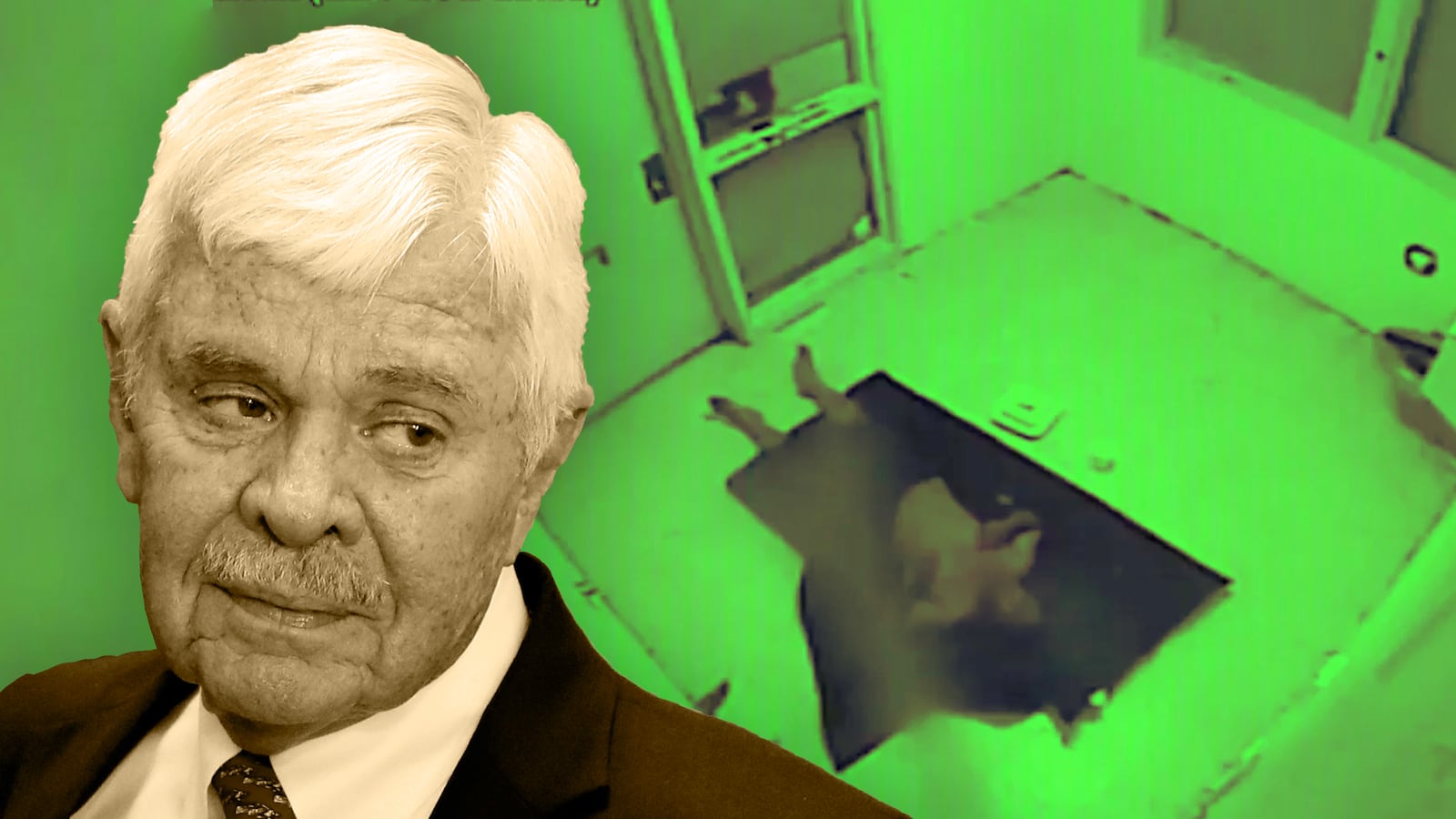An Oklahoma sheriff admitted that staff in his jail referred to black employees as “n*gronoids,” according to bombshell testimony in a Tulsa courthouse Monday.
The shocking allegation came during the wrongful-death trial for Elliott Williams—a 37-year-old Army vet who died at the Tulsa County jail in 2011. He was paralyzed on the floor of his cell and pleading for help for days, a federal lawsuit filed by his family claims.
On Monday, court testimony focused on accusations of systemic failures in the jail’s health care, and alleged racist practices within the sheriff’s office.
Former Sheriff Stanley Glanz testified that he didn’t take issue with the racially offensive terms “n*gronoids” or “n*groids,” stating that the FBI used them to describe black people in the 1960s or ’70s.
Glanz resigned in late 2015 following a two-count misdemeanor indictment (unrelated to the Williams case) relating to abuse of office.
The racist terminology was broached by Dan Smolen, an attorney for Williams’s estate who has also represented former employees who sued the Tulsa jail for racial discrimination. (A handful of cases filed by former lockup workers cost the county nearly $1 million to defend and settle, the Tulsa World reported.)
Glanz copped to using the word “n*gronoid” to refer to African-American staff during a 2015 deposition for a racial-discrimination case, court records reveal. (That case was later dismissed on summary judgment in favor of Glanz, in his individual capacity, and current Sheriff Vic Regalado, in his official capacity, court records show.)
On Monday night, Smolen told The Daily Beast that he first learned of jailers’ alleged use of the term after obtaining a 2006 memo (PDF) with the letter “N” marked next to the names of certain employees, along with an “M” or “F” to indicate gender.
The memo, filed as an exhibit in multiple federal discrimination cases against the sheriff’s office, reveals jail brass would mark an “N” or a “W” next to employees’ names to indicate whether they were black or white.
Smolen said he asked Glanz about the racist lettering during the 2015 deposition, expecting the sheriff to use a different N-word.
A review of deposition transcripts provides a deeper look into the allegations.
“How long did the sheriff’s office use that coding system to refer to their African-American employees?” Smolen asked, according to a review of the deposition transcript. Glanz replied, “Yeah, I don’t know.”
When asked whether using an “N” might be offensive to an American-American employee, Glanz testified, “No, sir.”
Smolen then asked, “What do you think the ‘N’ stands for?”
“N*gronoid,” Glanz said, according to the transcript. The sheriff then clarified, “Which is a race.”
Smolen asked whether the term is commonly used in the sheriff’s office. “No… to describe a white male or a n*gro or n*groid female or male is—I don’t see anything wrong with it,” Glanz said during the deposition.
“And do you continue to use, yourself, that terminology at the sheriff’s office?” Smolen asked, to which Glanz replied, “If I was describing a suspect, I probably would, yes.” Glanz said he would not, however, use it to describe a black employee. The term, he added, can be chalked up to “police lingo.”
Messages left for the sheriff’s attorneys were not returned as of press time.
The Williams trial began Feb. 22 in U.S. District Court before an all-white jury of five women and four men. The only black juror was dismissed early on to help care for his brother after surgery.
Glanz and the current sheriff, Vic Regalado, are defendants in the case, while the jail’s former medical provider, Correctional Healthcare Companies Inc., settled with Williams’s estate and is no longer named as a defendant.
Williams, who had no criminal record, was arrested on a misdemeanor obstruction charge in October 2011. The veteran was at an Owasso hotel and in the throes of a mental breakdown after his wife left him, his family says.
For days, Williams told detention officers that he couldn’t move or reach the water and food trays placed in his cell, a lawsuit filed by Williams’s family claims. But nurses told investigators they believed Williams was “faking” his paralysis. Instead of examining him, medical staff tried to catch him moving inside his video-monitored cell, court papers say.
Williams died of complications from a broken neck and was dehydrated at the time of his death, the medical examiner ruled.
Monday’s testimony also focused on systemic problems within the county jail.
Multiple audits and reviews by government agencies and consultants found repeat and widespread deficiencies in the jail’s medical care as early as 2007.
One audit by the Department of Homeland Security’s Office of Civil Rights and Civil Liberties, finished weeks before Williams died, described a “prevailing attitude of indifference among the clinic staff.”
Glanz testified that he did all he could to provide adequate medical care to inmates. “A lot of [deaths] occur because of their lifestyle and the condition that people find themselves in,” Glanz said on Monday.
The former sheriff also implied the contracted health provider was responsible for problems with the jail’s medical care. “They’re the ones who were actually responsible for the standards,” Glanz said, adding that he wanted the “best care for our inmates.”
Last week, experts for Williams’s legal team testified that his death would have been preventable with proper medical care.
Yet it’s unclear how Williams’s neck ended up broken. An Owasso cop slammed Williams to the floor while trying to handcuff him inside the jail’s booking area, according to the officer’s statements to the Oklahoma State Bureau of Investigation. The officer told state investigators that he “landed on top of Elliott’s shoulder and head” but that he “appeared to be fine with no injuries.”
Meanwhile, a fellow inmate claimed Williams rammed his head into his cell door, according to an internal probe by sheriff’s Capt. Billy McKelvey. While the sheriff’s lawyers have argued Williams was suicidal and therefore caused his own injury, Smolen appeared to question the jailbird’s account.
“If Mr. Williams was under constant supervision… can you explain why the only person who saw how Mr. Williams injured his head was an inmate that was interviewed two months after the fact?” Smolen asked Glanz.
Glanz said no, court transcripts show.
Deputies may have also exacerbated Williams’s injuries after dumping him in the shower, experts said last week.
Earlier in the trial, McKelvey testified that jailers put Williams on a gurney after he urinated and defecated on himself. Then they dumped him into the shower, where he smacked his head on the concrete floor, according to McKelvey’s investigation.
One of those officers, Capt. Tommy Fike, estimated Williams was in the shower for 30 minutes, McKelvey said. But Smolen presented McKelvey with a handwritten logbook showing that Fike, and Sgt. Doug Hinshaw, left Williams there for nearly two hours.
When Smolen asked Glanz about the shower incident last week, Glanz said he didn’t believe it happened as Smolen stated.
“The event, I don’t believe, occurred,” Glanz testified. He later added that Capt. Fike and Sgt. Hinshaw “were questioned about it, and both of them denied that it occurred the way you describe it.”
The erstwhile sheriff also testified that Williams was initially placed in a holding cell to “cool down” because he was “acting up.”
Glanz stated that Williams didn’t receive a mental-health screening, as required by jail policy, because of his alleged behavior.
Security footage of Williams in the booking room—previously played for jurors—does not appear to match this claim. Rather, the video shows that Williams stood up while waiting to be booked into the county jail.
When Smolen asked Glanz whether the jail had policies for a “cooling down” process, the ex-sheriff said he couldn’t recall any.
But Tulsa’s jail has another policy: requiring mental-health staff to keep constant watch over possibly suicidal inmates, Smolen said. In response, Glanz testified that Williams was under observation because he was in a holding cell with windows.
“Then why the mystery on how Mr. Williams broke his neck?” Smolen asked, according to court transcripts.
Glanz said he didn’t know.
Williams was not placed on suicide watch at the county jail, despite Owasso cops designating him as suicidal, Glanz testified. He said Williams was disruptive and that jailers’ decision to put him in a holding cell was appropriate. Asked by Smolen if he was troubled by Williams’s lack of mental evaluation, Glanz said no.
As The Daily Beast previously reported, Glanz testified that he didn’t watch the video of Williams’s final hours until one-and-a-half years later.
And when he did see the footage—ahead of a 2013 deposition—he said he didn’t see any indication Williams’s health was in danger. (Defense attorneys for the sheriff’s office have argued the video failed to capture Williams allegedly moving around, drinking, and eating.)
Glanz testified that his jail staff never asked him to see the footage. “If they would have made the recommendations, I would have viewed the video,” the ex-lawman said, according to court transcripts.
He later added, “If I was requested by my staff to view it and they thought it was important, I would have.”
Reporters Ziva Branstetter and Kassie McClung of The Frontier, a nonprofit news startup based in Tulsa, contributed to this report. For additional coverage on the Elliott Williams trial, please visit Readfrontier.org.






